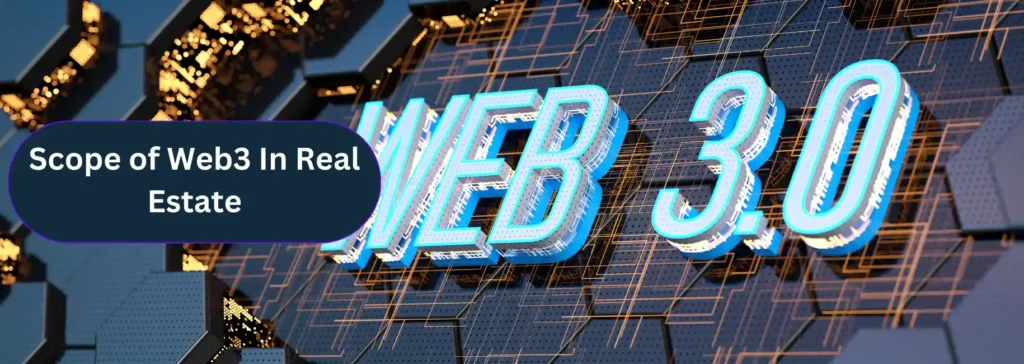Web3 authentication is like having a special password that no one else can guess or steal. It’s a new and secure way to sign in to websites without the worry of losing your password.
This is because it uses blockchain technology, which is a super safe way to keep records that bad guys can’t mess with easily.
More and more people like using Web3 authentication apps because it’s like having a secret handshake that only you know.
Did you know that in recent years, lots of people have had their online information stolen? That’s why we need a new, stronger way to lock our online doors.
Regular passwords aren’t enough these days—they’re like using a weak lock that can be broken.
In this article, we’ll explore how Web3 authentication flow works like a strong lock for your online safety. So get ready to learn about this cool new tool that could make the internet a safer place for everyone.
Contents
- 1 What is Web3?
- 2 Why is Web3 Authentication Necessary?
- 3 What are Web3 Wallets?
- 4 Types of Web3 Wallets
- 5 How to Perform Authentication and Authorization in Web3 Using a Wallet?
- 6 Importance of Keeping Keys Secure
- 7 How to Store and Validate the Roles in the Web3 Ledger?
- 8 Final Note
- 9 Frequently Asked Questions
- 9.1 Is Web3 authentication resistant to phishing attacks?
- 9.2 How does Web3 authentication handle user privacy?
- 9.3 Can Web3 authentication be used across different platforms?
- 9.4 Does Web3 authentication support multi-factor authentication (MFA)?
- 9.5 What are the potential challenges in adopting Web3 authentication?
What is Web3?
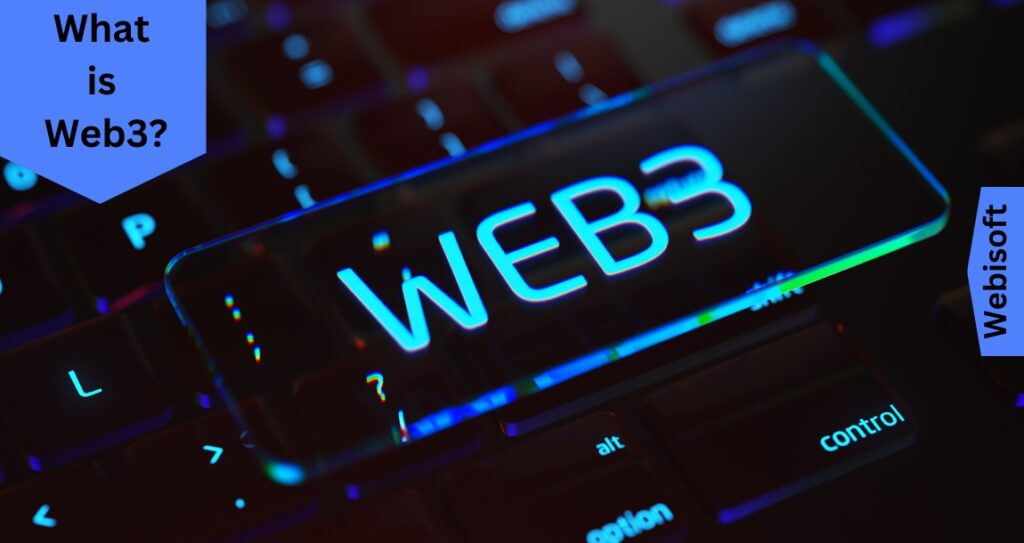
Web3 marks the next phase of the internet. It’s a place where every user has more control. Unlike the current web, where big companies own data, Web3’s core infrastructure returns power to the people.
You interact directly with this decentralized web, thanks to blockchain technology. Here, transactions and interactions occur without intermediaries.
Features of web3 technology:
- It is decentralized
- Uses cryptocurrency
- Trustless
- Secured and reliable
Why is Web3 Authentication Necessary?
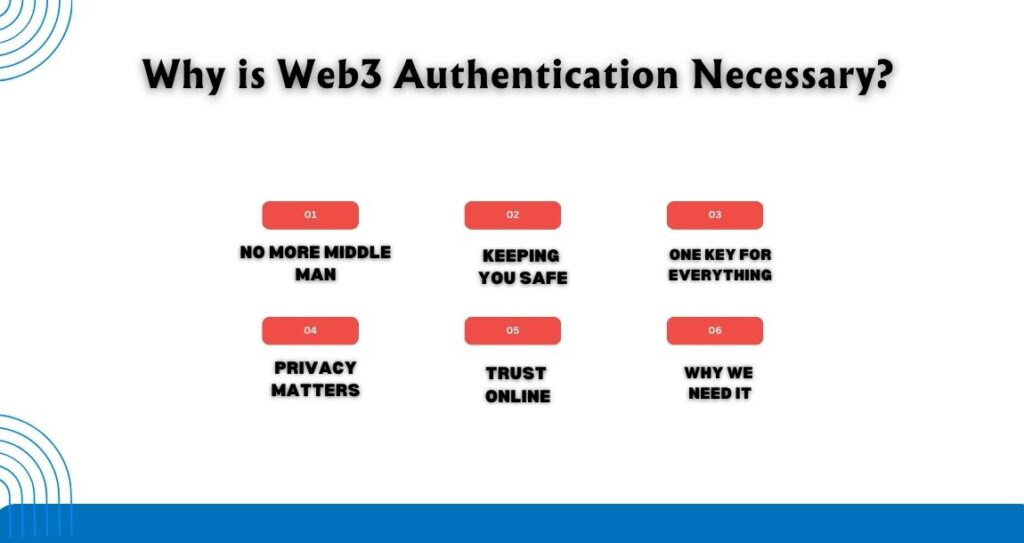
Dynamic web3 authentication changes how we use the internet. It’s new and gives everyone more control. Before Web3, big companies held all the data. Now, with Web3, we get to hold onto our own stuff.
No More Middle Man
Web3 works on something called blockchain. It’s like a digital ledger that’s safe and can’t be changed easily.
This means when you do something online, like sending a message or buying something, you don’t need a company in the middle. It’s just you and the other person.
Keeping You Safe
Web3 Authentication is a way to make sure you are you. Instead of using a bunch of passwords, you use special codes that belong only to you. It’s like having a super-secure lock that only opens with your fingerprint.
One Key for Everything
Imagine having one key that opens every door you need. That’s how implementing web3 authentication works. You use one secure key to get into all your online places. No more trying to remember lots of passwords.
Privacy Matters
With Web3, your private stuff stays private. You can share what you want and keep the rest to yourself. It’s good for people who want to stay private but still do things online.
Trust Online
When you buy or sell things online, you want to trust the other person. Web3 Authentication helps with that.
It makes sure everyone is who they say they are. So, you can feel good about dealing with people you meet on the internet.
Why We Need It
We need web3 authentication api because it makes the internet safer and easier for everyone. It’s a big step towards a better internet where we all have more control and more trust.
What are Web3 Wallets?
Web3 wallets are the latest tools for managing digital assets and identities online. Think of them as your virtual pocketbook, not just for storing digital money like Bitcoin or Ethereum, but also for holding your identity in the online world.
These wallets let you interact with Web3 applications, where you can use cryptocurrencies, play games, or even buy virtual land.
Web3 wallets come in different shapes and sizes, each with unique features. Some are software wallets, which you can download as apps on your phone or run on your computer.
They’re convenient and always just a few clicks away. Hardware wallets, on the other hand, are physical devices.
They’re like high-tech USB drives that store your digital assets offline, which makes them super secure. You also find paper wallets, which are essentially pieces of paper with your digital keys printed on them – they’re as simple as they sound but require careful handling.
Types of Web3 Wallets
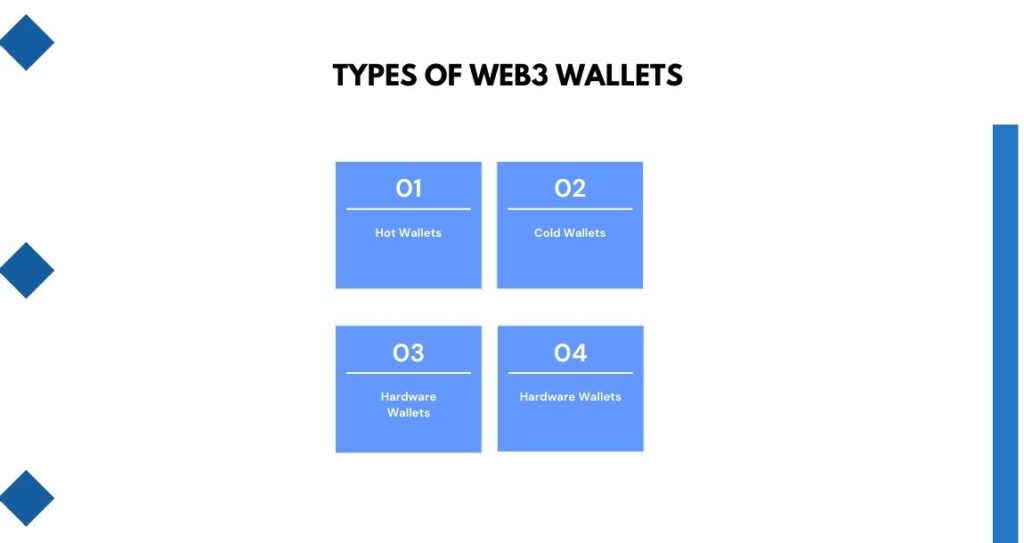
The world of Web3 wallets is diverse, offering various ways to manage and secure digital assets. Each type of wallet serves a specific purpose and caters to different user needs, ranging from constant accessibility to impenetrable security.
Hot Wallets: Your Everyday Digital Wallet
Hot wallets are akin to the wallets we carry in our pockets but for the digital realm. They are always connected to the internet, which means they are ready to perform transactions at any moment.
This constant connectivity brings convenience for quick trades and payments, making them a favorite for daily use. However, their online nature makes them vulnerable to online threats.
Thus, they are generally used to hold smaller amounts of assets, similar to the cash one might carry for everyday expenses.
To ensure security, hot wallet providers implement robust security measures like two-factor authentication and regular software updates.
Cold Wallets: The Digital Safe
Cold wallets are the digital equivalent of a vault. They remain offline, only coming online when absolutely necessary.
This detachment from the internet shields them from hacking attempts and unauthorized access, making them ideal for storing large amounts of assets long-term.
They’re often used by individuals who want to “hodl” their assets, akin to a long-term investment strategy. Users typically transfer assets to a hot wallet only when they need to make transactions, maintaining the security of their larger holdings.
Hardware Wallets: Tangible Security
Hardware wallets offer a tangible way to manage digital assets. They are physical devices, often resembling a USB drive, that can store a user’s private keys securely offline.
To make a transaction, one must connect the hardware wallet to a computer or smartphone, authorize the transaction on the device, and then disconnect it, returning to a state of cold storage.
They are a form of cold wallet but with added convenience for occasional transactions. The physical nature of these devices also adds a layer of psychological comfort for users, as they can physically handle and secure their digital investments.
Paper Wallets: The Analog Key to Digital Assets
Paper wallets are perhaps the simplest form of cold storage. They consist of a physical document that contains a user’s private and public keys, often in the form of QR codes.
To access or send assets, one would scan the QR code, perform the necessary actions, and then store the paper securely again.
They are immune to digital hacking attempts but come with the risk of being physically damaged or lost.
It’s essential to keep them in a safe, possibly fireproof location, and consider making multiple copies to safeguard against accidental loss.
How to Perform Authentication and Authorization in Web3 Using a Wallet?
Authentication in Web3 is a seamless process, designed to ensure that users can prove their identity without the need for traditional passwords.
Connecting Your Wallet: The First Handshake
When you visit a Web3 service, the first step is usually to connect your wallet. This process involves a digital handshake between the service and your wallet, establishing your ownership of the wallet’s address.
The service will display a pop-up or a prompt, asking you to confirm the connection. Once confirmed, your wallet’s public address is shared, proving your identity without revealing sensitive information, such as your private keys.
Signing a Message: Your Digital Signature
For additional security, a service may ask you to sign a message. This is akin to providing a fingerprint; it’s unique to you and cannot be forged.
By using your private key to sign a transaction or message, you are affirming your identity and intentions without transmitting your private key.
This signature can be verified by anyone, but only the wallet’s owner can produce it, ensuring the integrity of the authentication process.
Approvals and Permissions: The Gatekeepers
Each time a transaction or a significant action is initiated, your wallet will prompt you to approve it. This step is crucial as it provides users with the autonomy to control what actions are taken with their assets.
Approvals are the gatekeepers, ensuring that nothing happens without the user’s explicit consent. This layer of security is what makes Web3 wallets a powerful tool for managing digital identity and assets.
The Significance of Wallets in Web3
Web3 wallets are not just storage for digital assets; they are the backbone of digital identity and authorization in the decentralized internet.
They offer an intuitive and secure interface for users to interact with decentralized applications and services.
Understanding the nuances of different wallet types and the authentication process is pivotal for anyone looking to navigate the Web3 space securely and effectively.
Importance of Keeping Keys Secure
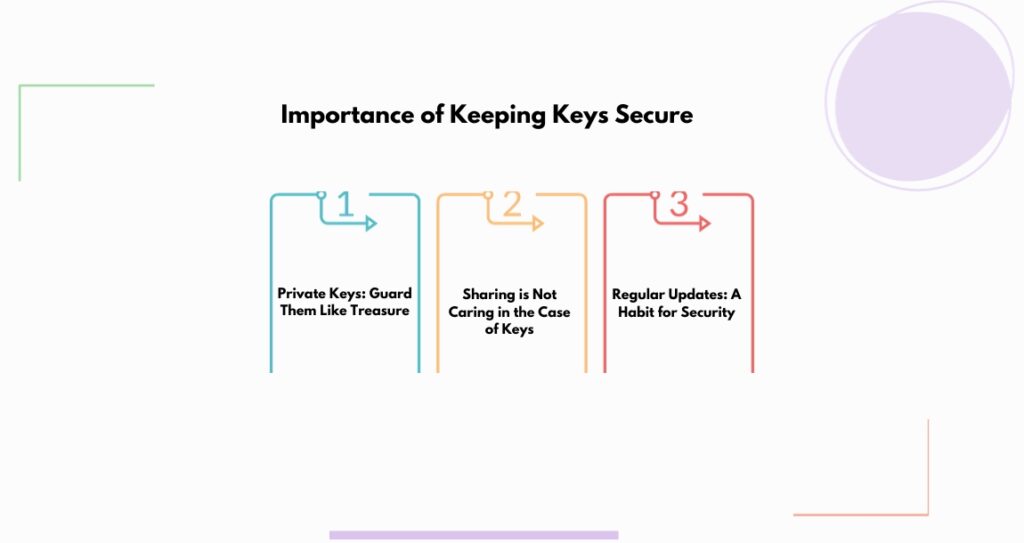
Secure keys are the bedrock of digital safety in Web3. They are the secret codes that lock away your digital valuables.
Without proper protection, these keys can fall into the wrong hands, leading to loss or theft of your digital assets.
Keys act as both the lock and key to your online vault; hence, keeping them safe is paramount.
Private Keys: Guard Them Like Treasure
Private keys are like the master keys to your digital kingdom. You must guard them with utmost care. Losing them is akin to giving a thief keys to your home. Store them in places only you can access.
Consider using secure password managers or encrypted storage devices specifically designed for such sensitive information.
Sharing is Not Caring in the Case of Keys
One golden rule in the digital world is never to share your private keys. Not with friends, not even with family.
These keys are meant for your eyes only. Treat them as you would a secret only you should know. Even service providers should never ask for your private keys.
Regular Updates: A Habit for Security
Updating software can be a chore, but it’s crucial for security. Wallet software updates often include security enhancements. Always download the latest versions from trusted sources.
Outdated software can have vulnerabilities that hackers exploit. Keeping your wallet software up-to-date is like upgrading your locks to keep thieves out.
How to Store and Validate the Roles in the Web3 Ledger?
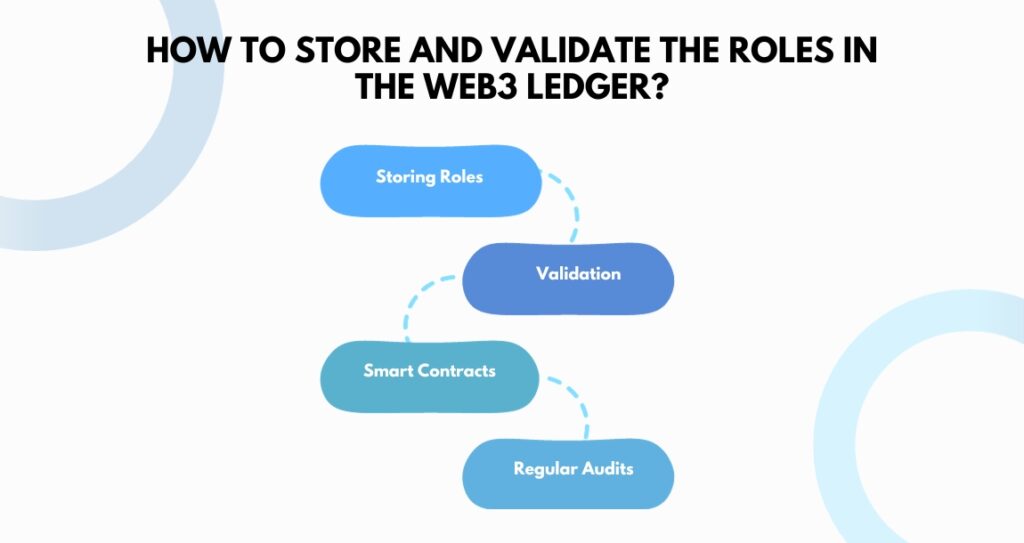
The Web3 ledger is more than just a record of transactions; it’s the foundation of decentralized identity and permissions.
Understanding how to store and validate roles within this ledger is critical for maintaining a secure and functional ecosystem.
Storing Roles: A Place for Everything
Think of the ledger as a big book where each role is a title with specific access rights. Storing roles on the ledger requires meticulousness, assigning each role its permissions and limitations.
This ensures that only authorized individuals can execute certain actions within a decentralized application.
Validation: The Checkpoint of the Web3 World
Validating roles is like a checkpoint in a secured facility. It involves verifying that an individual’s role corresponds to the permissions they’re trying to exercise.
This process typically involves smart contracts that automatically check the ledger to confirm roles before any action is taken.
Smart Contracts: The Enforcers of the Ledger
Smart contracts are the rule enforcers of the Web3 world. They automatically execute actions when certain conditions are met.
When it comes to roles and permissions, they can approve or deny transactions based on the role data stored in the ledger.
Regular Audits: The Pulse Check of the System
Performing regular audits on how roles are stored and validated is like a health check for the system. It ensures that everything is functioning as intended and that no unauthorized changes have been made.
This can prevent potential breaches and maintain the integrity of the decentralized network. In the Web3 space, keys unlock the future of digital ownership and identity. They demand the highest level of security.
Storing and validating roles within the Web3 ledger is a sophisticated process, underpinned by smart contracts and regular checks.
By adhering to these practices, users and developers can safeguard their digital assets and maintain the trustless integrity that is the hallmark of Web3.
Final Note
Web3 authentication stands out because it puts privacy first. Imagine locking and unlocking digital doors with a key only you own.
That’s web3 authentication. It’s a favorite because it lets users control their identity without relying on big companies. No more middlemen holding your keys; you’re the boss.
Alternatives to traditional log-ins are needed now more than ever. Data breaches are common, and privacy is a growing concern. Web3 offers a new way to stay safe online.
The journey through web3 authentication is like unlocking the future of security, one where the blockchain developers hold all the keys. It’s about taking back control and stepping into a world where your digital self is yours, truly.
Interested in learning more about secure, user-friendly web authentication? Reach out to Webisoft for cutting-edge solutions that put you in control.
Frequently Asked Questions
Is Web3 authentication resistant to phishing attacks?
Since there are no passwords to steal and authentication happens on the blockchain, it is inherently more resistant to phishing attacks.
How does Web3 authentication handle user privacy?
It allows users to control their own data and choose how much information to share, offering a higher level of privacy compared to traditional methods.
Can Web3 authentication be used across different platforms?
Yes, it’s designed to be interoperable, meaning users can use their Web3 identity across various platforms that support the technology.
Does Web3 authentication support multi-factor authentication (MFA)?
It inherently supports MFA by combining blockchain-based verification with other identifiers, like biometrics or hardware tokens.
What are the potential challenges in adopting Web3 authentication?
The main challenges include the need for widespread adoption, user education, and the integration of Web3 technology with existing platforms.
